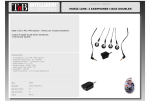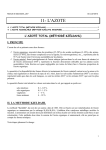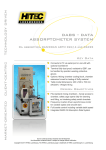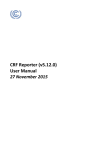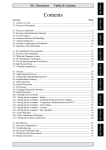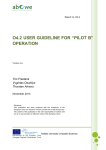Download Kodak ECN-0002/1 User's Manual
Transcript
Titrimetric Determination of Hypo Index, Thiosulfate, and Sulfite in EASTMAN Color Films, Process ECN-2 Fixer ECN-0002/1 Process ECN-2 ECP-2D VNF-1/LC RVNP Formulas F-34a/F-34aR — — — INTRODUCTION This method describes the titrimetric determination of hypo index (total reductants), thiosulfate, and sulfite in EASTMAN Color Films, Process ECN-2, fixers. It is recommended that these determinations be carried out by a potentiometric titrimetric approach, using an auto-titrator. However, for those unable to use instrumentation, the manual titrimetric technique, using the visual starch indicator, is included. For the potentiometric measurement, a Metrohm Potentiograph, Model E536 or equivalent should be used. The potentiometric titration requires a platinum indicator electrode and a double-junction reference electrode. The Hypo Index (HI) or total reductants of a fixer is defined as the millilitres of 0.1 N iodine consumed by the thiosulfate and sulfite combined (reaction 1 & 2), in a specified volume of fixer. The fixer is added to an excess of iodine (liberated from the reaction of potassium iodate and potassium iodide under acidic conditions - reaction 3). The unreacted iodine is titrated either potentiometrically or visually with standardized sodium thiosulfate from the appropriate capacity burette. The difference between the blank titration and the sample titration represents the milliequivalents of iodine consumed by the sample. Dividing the milliequivalents of iodine by 0.1 meq/mL yields the HI of the sample. Hypo index is reported in the terms of HI(1), mL which is the millilitres of 0.1000 N I2 consumed by 1.0 mL of sample. 2 S2O3 + I2 → 2I + S4O6 = - = (reaction 1) HSO3 + I2 + H2O → SO4 + 2I + 3H = = - + (reaction 2) IO3 + 5I + 6H → 3I2 + 3H2O (reaction 3) Na2SO3 + HCHO + H2O → CH3(OH) SO3Na + NaOH (reaction 4) - - + The thiosulfate is determined potentiometrically by adding 6 percent formaldehyde to a second sample aliquot in reagent water. Under these conditions, the sulfite in the sample forms a formaldehyde bisulfite complex (reaction 4). This sample is then added to an excess of acidified iodine. The unreacted iodine is titrated either potentiometrically with standardized sodium thiosulfate from a 50-mL capacity burette. The difference between the blank titration and the sample titration represents the milliequivalents of iodine consumed by the thiosulfate in the sample. The thiosulfate is expressed as g/L thiosulfate ion (S2O3=). The thiosulfate is determined by the visual titration by adjusting the pH of a sample aliquot to 8.5. At this pH, the sulfite rapidly forms the stable sulfite - formaldehyde adduct. Upon acidification, which prevents the adduct from reacting with iodine, the thiosulfate from the sample is titrated with standardized iodine reagent to a starch end point. The sulfite content is calculated by subtracting the milliequivalents of iodine consumed by the thiosulfate from the milliequivalents of iodine consumed by the thiosulfate and sulfite. The sulfite is reported as sodium sulfite. Use of this method requires handling potentially hazardous chemicals. Consult the Material Safety Data Sheet for each chemical before use. MSDS’s are available from your chemical supplier. PRECISION AND BIAS Repeatability To obtain the repeatability data, a single skilled analyst performed five (5) replicates on each of the following solutions (this procedure was done by both potentiometric and visual end point detection): a. A “fresh” EASTMAN Color Films, Process ECN-2, Fixer prepared with all components at their respective aim concentrations in a working tank. b. A “seasoned” EASTMAN Color Films, Process ECN-2, Fixer analyzed as received at 125.67 g/L thiosulfate ion and 28.92 g/L sodium sulfite. c. The same “seasoned” solution as in number b, above, reanalyzed after making standard additions of 37.850 g/L thiosulfate ion and 8.415 g/L sodium sulfite. Reproducibility Three EASTMAN Color Films, Process ECN-2, Fixer samples were analyzed by four analysts, each using different titration stations, on two different days. Each analyst analyzed each sample by both the potentiometric and the visual end point technique. Duplicate analyses were performed on each sample, on each of the two days. These samples were: a. a “fresh” tank solution prepared at 109.212 g/L thiosulfate ion and 21.335 g/L sodium sulfite. b. an EASTMAN Color Films, Process ECN-2 “seasoned” tank fixer sample analyzed, as received, in the same manner as the “fresh” fixer. c. the same (as in number b, above) EASTMAN Color Films, Process ECN-2 “seasoned” tank fixer sample reanalyzed in the same manner as the “fresh” fixer, after standard additions of thiosulfate and sulfite were made. The “seasoned” sample of EASTMAN Color Films, Process ECN-2 fixer, analyzed to be 115.17 g/L thiosulfate ion and 15.69 g/L sodium sulfite. Standard Processing KODAK Motion Picture Films, Module 3, Analytical Procedures • H24.03 1 additions of 34.57 g/L thiosulfate ion and 5.444 g/L sodium sulfite were made to that “seasoned” sample. POTENTIOMETRIC TITRATION STATISTICS Repeatability Standard Deviation, 1sr & 95 Percent Confidence Estimate (not including bias) Repeatability standard deviation is an estimate of the variability one trained analyst should be able to obtain under favorable conditions (analyzing a sample, with one instrument, within one day). The 95 percent confidence estimate (calculated using the repeatability standard deviation) around a single test will include the mean value 95 percent of the time. HYPO INDEX (1 mL) Repeatability Samples Mean Level (N) Standard Deviation, 1Sr (Process ECN-2 Fixer) (mL 0.1 N I2) (mL 0.1 N I2) 95 Percent Confidence Estimate (mL 0.1 N I2) “Fresh” at “Aim” 10.02 5 0.086 ± 0.24 “Seasoned”, As Received 15.80 5 0.073 ± 0.20 “Seasoned” with Standard Addition 19.38 5 0.14 ± 0.39 THIOSULFATE Repeatability (N) Standard Deviation, 1Sr = (g/L S2O3 ) 95 Percent Confidence Estimate = (g/L S2O3 ) Samples (Process ECN-2 Fixer) Mean Level = (g/L S2O3 ) “Fresh” at “Aim” 81.18 5 0.67 ± 1.9 “Seasoned”, As Received 125.67 5 0.47 ± 1.3 “Seasoned” with Standard Addition 153.79 5 0.60 ± 1.7 SULFITE Repeatability Samples Mean Level (N) Standard Deviation, 1Sr (Process ECN-2 Fixer) (g/L Na2SO3) (g/L Na2SO3) 95 Percent Confidence Estimate (g/L Na2SO3) “Fresh” at “Aim” 17.55 5 0.69 ± 1.9 “Seasoned”, As Received 28.92 5 0.65 ± 1.8 “Seasoned” with Standard Addition 35.69 5 1.18 ± 3.3 Bias Bias is a statistically significant deviation of the mean from the known mix level at a 95 percent confidence level. It is determined for “fresh” samples only. Bias is not determined for “seasoned” samples, since the component concentration level was not determined independently of the test method. A statistically significant bias for thiosulfate of (-1.09 percent) was found for a “fresh” tank Process ECN-2 Fixer sample. The biases for Hypo Index and Sodium Sulfite were not statistically significant. However, the bias for thiosulfate was judged not to be practically significant. 2 Processing KODAK Motion Picture Films, Module 3, Analytical Procedures • H24.03 Recovery Recovery is used instead of bias for “seasoned” samples, since the component concentration level was not determined independently of the test method. It is defined as the calculated mean for the “seasoned” sample with a standard addition of the component minus the mean for the “seasoned” sample, divided by the actual amount of the standard addition. It is expressed as a percentage. The table below shows whether or not a recovery is statistically or practically different from 100 percent. POTENTIOMETRIC RECOVERY, Process ECN-2 Analyte Recovery Value Statistically Significant Practically Significant Hypo Index (1 mL) 76% Yes No = 74% Yes No 80.4% No No Thiosulfate (S2O3 ) Sodium Sulfite (Na2SO3) Reliability Customer Standard Deviation, 1sc & 95 Percent Confidence Estimate (not including bias) The customer standard deviation is an estimate of the variability a customer could expect when submitting a sample to any Photoprocessing Quality Services laboratory, where any trained analyst could test the sample using any instrument on any day. The 95 percent confidence estimate (calculated using the customer standard deviation) around a single test result will include the mean value 95 percent of the time. HYPO INDEX Samples (Process ECN-2 Fixer) Reproducibility 95 Percent Mean Level (N) Standard Deviation, 1Sc Confidence Estimate (mL 0.1 N I2) (mL 0.1 N I2) (mL 0.1 N I2) “Fresh” at “Aim” 12.88 16 0.25 ± 0.54 “Seasoned”, As Received 12.73 16 0.13 ± 0.27 “Seasoned” with Standard Addition 15.83 16 0.16 ± 0.33 THIOSULFATE Reproducibility 95 Percent (N) Standard Deviation, 1Sc Confidence Estimate = = (g/L S2O3 ) (g/L S2O3 ) Samples (Process ECN-2 Fixer) Mean Level = (g/L S2O3 ) “Fresh” at “Aim” 108.14 16 0.94 ± 2.00 “Seasoned”, As Received 114.86 16 0.73 ± 1.56 “Seasoned” with Standard Addition 142.23 16 0.78 ± 1.67 SULFITE (Na2SO3) Samples (Process ECN-2 Fixer) Reproducibility 95 Percent Mean Level (N) Standard Deviation, 1Sc Confidence Estimate (g/L Na2SO3) (g/L Na2SO3) (g/L Na2SO3) “Fresh” at “Aim” 20.79 15 0.59 ± 1.26 “Seasoned”, As Received 15.70 16 0.68 ± 1.45 “Seasoned” with Standard Addition 19.85 16 0.76 ± 1.63 Processing KODAK Motion Picture Films, Module 3, Analytical Procedures 3 VISUAL TITRATION STATISTICS Repeatability Standard Deviation, 1sr and 95 Percent Confidence Estimate Repeatability standard deviation is an estimate of the variability one trained analyst should be able to obtain under favorable conditions (analyzing a sample, with one instrument, within one day). HYPO INDEX (3.0 mL) Samples (Process ECN-2 Fixer) Mean Level (N) (mL 0.1 N I2) Repeatability Standard Deviation, 1Sr (mL 0.1 N I2) 95 Percent Confidence Estimate (mL 0.1 N I2) “Fresh” at “Aim” 29.42 5 0.089 ± 0.25 “Seasoned”, As Received 47.29 5 0.060 ± 0.17 “Seasoned” with Standard Addition 57.65 5 0.084 ± 0.23 = THIOSULFATE (S2O3 ) Samples (Process ECN-2 Fixer) Mean Level = (g/L S2O3 ) (N) Repeatability Standard Deviation, 1Sr = (g/L S2O3 ) 95 Percent Confidence Estimate = (g/L S2O3 ) “Fresh” at “Aim” 81.37 5 0.10 ± 0.28 “Seasoned”, As Received 125.29 5 0.24 ± 0.67 “Seasoned” with Standard Addition 155.73 5 0.19 ± 0.53 SULFITE (Na2SO3) Samples (Process ECN-2 Fixer) Mean Level (N) (g/L Na2SO3) Repeatability Standard Deviation, 1Sr (g/L Na2SO3) 95 Percent Confidence Estimate (g/L Na2SO3) “Fresh” at “Aim” 16.08 5 0.18 ± 0.50 “Seasoned”, As Received 28.93 5 0.24 ± 0.67 “Seasoned” with Standard Addition 33.43 5 0.31 ± 0.86 Bias Bias is a statistically significant deviation of the mean from the known mix level at a 95 percent confidence level. It is determined for “fresh” samples only. Bias is not determined for “seasoned” samples, since the component concentration level was not determined independently of the test method. Statistically significant biases were found for hypo index, thiosulfate, and sodium sulfite (see the table below) for a “fresh” tank Process ECN-2 Fixer sample. However, the individual biases for hypo index, thiosulfate, or sodium sulfite were judged not to be practically significant. 4 Bias (Measurement Unit of Analyte) Bias (%) Hypo Index (mL 0.1 N I2) – 0.82 – 2.71% Thiosulfate = (g/L S2O3 ) – 0.696 – 0.85% Sodium Sulfite (Na2SO3) – 1.322 – 7.6% Analyte Processing KODAK Motion Picture Films, Module 3, Analytical Procedures Recovery Recovery is used instead of bias for “seasoned” samples, since the component concentration level was not determined independently of the test method. It is defined as the calculated mean for the “seasoned” sample with a standard addition of the component minus the mean for the “seasoned” sample, divided by the actual amount of the standard addition. It is expressed as a percentage. The table below show whether or not a recovery is statistically or practically significant from 100 percent. VISUAL RECOVERY, Process ECN-2 Analyte Recovery Value Statistically Significant Practically Significant Hypo Index (1 mL) 73.3% Yes No = Thiosulfate (S2O3 ) 80.4% Yes No Sodium Sulfite (Na2SO3) 53.4% Yes No Customer Standard Deviation, 1sc & 95 Percent Confidence Estimate (not including bias) The customer standard deviation (1sc) is an estimate of the variability a customer could expect when submitting a sample to any Photoprocessing Quality Services laboratory, where any trained analyst could test the sample using any instrument on any day. The 95 percent confidence estimate (calculated using the customer standard deviation) around a single test result will include the mean value 95 percent of the time. HYPO INDEX (1.0 mL) Samples (Process ECN-2 Fixer) Reproducibility 95 Percent Mean Level (N) Standard Deviation, 1Sc Confidence Estimate (mL 0.1 N I2) (mL 0.1 N I2) (mL 0.1 N I2) “Fresh” at “Aim” 12.97 16 0.18 ± 0.39 “Seasoned”, As Received 12.70 16 0.15 ± 0.31 “Seasoned” with Standard Addition 15.93 16 0.20 ± 0.43 = THIOSULFATE (S2O3 ) Reproducibility 95 Percent (N) Standard Deviation, 1Sc Confidence Estimate = = (g/L S2O3 ) (g/L S2O3 ) Samples (Process ECN-2 Fixer) Mean Level = (g/L S2O3 ) “Fresh” at “Aim” 107.95 16 0.93 ± 1.99 “Seasoned”, As Received 114.95 16 0.97 ± 2.06 “Seasoned” with Standard Addition 142.59 16 1.07 ± 2.28 SULFITE (Na2SO3) Samples (Process ECN-2 Fixer) Reproducibility 95 Percent Mean Level (N) Standard Deviation, 1Sc Confidence Estimate (g/L Na2SO3) (g/L Na2SO3) (g/L Na2SO3) “Fresh” at “Aim” 21.17 16 1.18 ± 2.52 “Seasoned”, As Received 15.46 16 1.14 ± 2.43 “Seasoned” with Standard Addition 20.23 16 1.58 ± 3.38 Processing KODAK Motion Picture Films, Module 3, Analytical Procedures 5 APPARATUS PROCEDURE All volumetric glassware should meet all “Class A” specifications, as defined by American Society for Testing and Materials (ASTM) Standards E 287, E 288, and E 969, unless otherwise stated. For Potentiometric Titration: • Metrohm Potentiograph, Model E536 or equivalent titrator For Potentiometric Titration • Metrohm Model 665 Dosimat with a 50-mL burette size (no substitution) • Electrodes: Indicator electrode = Platinum inlay (i.e., Beckman Model 39273 or equivalent) Double-junction (i.e., Orion Reference electrode = 900200 or equivalent) (10% KNO3 outer filling solution) For Visual Titration: • Burette, Class A, 50 mL capacity, Teflon stopcock • Magnetic Stirrer A. Hypo Index (HI) or Total Reductants 1. To a 400-mL beaker with a magnetic stir-bar, add 100 mL reagent water. 2. Pipette 40.0 mL (use a 20-mL pipette, twice) of standardized 0.1 N potassium iodate into the 400-mL beaker. 3. While stirring, add 10 mL of 2.0 N acetic acid and 25 mL of 0.6 M potassium iodide (KI) to the 400-mL beaker. 4. With continued stirring, immediately pipette 1.0 mL of sample near the surface of the liquid. Rinse the sides of the beaker with reagent water. 5. Titrate with standardized 0.1 N sodium thiosulfate on an E536 Metrohm Potentiograph or equivalent titrator. If using an E536, titrate the solution from step 4, using the following parameters: Rate = 10 min/100% vol Auto Control = OFF REAGENTS Use ACS Reagent Grade reagents unless otherwise specified. • Potassium Iodate, KIO3 (0.1 N), - standardized to four decimal places • Acetic Acid, CH3COOH (2.0 N) Mode = mV/pH Range = 500 mV Burette Size = 50 mL Indicator Electrode = Platinum inlay or platinum wire (i.e., Beckman Model 39273) • Potassium Iodide, KI (0.6 M) • Sodium Thiosulfate, Na2S2O3 (0.1 N) - standardized to four decimal places • Formaldehyde (6%), pH 3.9 • Starch Indicator • Phenolphthalein Indicator • Sodium Hydroxide, NaOH (1.0 N) • Sulfuric Acid, H2SO4 (1.0 N) • Iodine, I2 (0.1 N) - standardized to four decimal places Reference Electrode = Double-junction reference (i.e., Orion Model 90-02) 6. Determine the volume of 0.1 N sodium thiosulfate at the end point using concentric arcs (see Universal Method ULM-0003-01, Potentiometric Titrations for Photoprocessing Solutions, or subsequent revision). 7. Run a blank (do steps 1–6, but omit the addition of the sample in step 4). • Water, Type I Reagent – This method was developed, and the resulting statistical data were obtained using reagent water equivalent to or purer than Type I Grade, as defined in ASTM Standard D 1193. Other grades of water, e.g., reverse osmosis (RO), demineralized, or distilled water, may give equivalent results, but the effects of water quality on method performance have not been studied. 6 Processing KODAK Motion Picture Films, Module 3, Analytical Procedures • H24.03 B. Thiosulfate Determination 1. Sample Pretreatment: a. To a 250-mL beaker with a magnetic stir-bar, add 75 mL of reagent water. b. Pipette 2.0 mL of sample into the 250-mL beaker. c. Add 5 mL of 6% formaldehyde (pH 3.9) to the beaker. d. Start stirring the contents of the 250-mL beaker, set and start a timer for 2 minutes of stirring. 2. Titration of Sample: a. Into a 400-mL beaker with a magnetic stir-bar, pipette 40.0 mL of standardized 0.1 N potassium iodate while the timer from step 1.d. is running. b. While stirring, add 10 mL of 2.0 N acetic acid to the 400-mL beaker (continue stirring through step 2e.). c. When the timer goes off, add 25 mL of 0.6 M KI to the 400-mL beaker. d. Immediately after the 0.6 M KI has been added, add the solution in the 250-mL beaker, from step 1, Sample Pretreatment:, to the 400-mL beaker. e. f. g. Rinse the 250-mL beaker three times with reagent water and add the rinses to the 400-mL beaker. Titrate the contents of the 400-mL beaker with standardized 0.1 N sodium thiosulfate on an E536 Metrohm Potentiograph or equivalent titrator. If using a Metrohm E536, titrate the solution from step 2e. using the parameters found in step 5 of the Hypo Index (HI) or Total Reductants procedure. Determine the volume of 0.1 N sodium thiosulfate at the end point using concentric arcs (see Universal Method ULM-0003-01, Potentiometric Titrations for Photoprocessing Solutions, or any subsequent revision. 3. Run a blank, following all the steps in 1 and 2 above, except omit the addition of sample in step 1b. C. Sulfite 1. Sulfite is a calculated value and requires no additional measurement. For Visual Titration A. Hypo Index (HI) or Total Reductants Treatment and Titration of Sample: 1. Pipette (wipe before leveling) 40.0 mL of standardized 0.1 N potassium iodate solution into a 250-mL conical flask containing a magnetic stir bar. 2. Add 10 mL of 2.0 N acetic acid solution from a tip-up (or equivalent) pipette. 3. Stir the solution with a magnetic stirrer and add 25 mL of 0.6 M potassium iodide solution from a tip-up pipette. 4. Immediately pipette (wipe) 1.0 mL of the fixer sample into the 250-mL flask while the solution is stirring (hold the tip of the pipette against the wall of the flask and as close to the surface of the stirring solution as possible while the sample is draining but do not immerse the tip of the pipette in the stirring solution). 5. Titrate with standardized 0.1 N sodium thiosulfate solution to a light yellow color. 6. Add 5 mL of the starch indicator, from a tip-up pipette and continue the titration until the blue color just disappears for 15 seconds. 7. Run a blank (do steps 1–6, but omit the addition of the sample in step 4). B. Thiosulfate (Hypo) 1. Treatment of the Sample: a. Pipette 2.0 mL of the fixer sample into a 250-mL conical flask containing a magnetic stir bar. b. Add 5 mL of formalin from a tip-up pipette. c. Add 3 or 4 drops of phenolphthalein indicator to the flask. • If the solution is pink, titrate with 1.0 N sulfuric acid to colorless. • If the solution is colorless, titrate with 1.0 N sodium hydroxide to the first light pink color. d. Let the solution stand for 2 minutes. e. Add 10 mL of 2.0 N acetic acid from a tip-up pipette. 2. Titration with Iodine: a. Add, from a tip-up pipette, 5 mL of the starch indicator to the conical flask. b. Titrate with standardized 0.1 N iodine solution to the first distinct blue color that persists for 15 seconds. C. Sulfite 1. Sulfite is a calculated value and requires no additional measurement. Processing KODAK Motion Picture Films, Module 3, Analytical Procedures • H24.03 7 CALCULATIONS For Potentiometric Titration A. Hypo Index (HI) or Total Reductants: (mL Blank A – mL Sample A) (N Na2S2O3) HI (1), mL = 0.1000 N Na2S2O3 Where: HI (1), mL = mL of 0.1000 N I2 consumed by 1.0 mL sample mL Blank A = millilitres of titrant at the end point of the blank titration of potentiometric Procedure A. mL Sample A = millilitres of titrant at the end point of the sample titration of potentiometric Procedure A. N Na2S2O3 = normality of the titrant (meq/mL) 0.1000 = nominal value for the normality of the titrant, in meq/mL B. Thiosulfate (S2O3=): = g/L S2O3 = (mL Blank B – mL Sample B)(N Na2S2O3)(112.13)(1000) sample size (1000) Where: mL Blank B = millilitres of titrant at the end point of the blank titration of potentiometric Procedure B mL Sample B = millilitres of titrant at the end point of the sample titration of potentiometric Procedure B. N Na2S2O3 = normality of the titrant (meq/mL) 112.13 = equivalent weight of thiosulfate expressed in mg/meq 1000 = conversion factor of milligrams to grams 1000 = conversion factor of millilitres to litres sample size = sample size used in potentiometric Procedure B (2.0 mL) C. Sodium Sulfite (Na2SO3): mL Blank A – mL Sample A = D mL A mL Blank B – mL Sample B = D mL B g/L Na2SO3 = [(D mL A)(2.0) – (D mL B)](N Na2S2O3)(63.02)(1000) sample size (1000) Where: N Na2S2O3 = normality of the titrant 2.0 = conversion of hypo index to 2.0 mL sample size 63.02 = equivalent weight of sodium sulfite in mg/ meq 1000 = conversion factor of milligrams to grams sample size = sample size used in potentiometric Procedure B (2.0 mL) 1000 = conversion factor of millilitres to litres 8 Processing KODAK Motion Picture Films, Module 3, Analytical Procedures • H24.03 Example Potentiometric Calculations: Titration mL 0.1 N Na2S2O3 Titrant Blank A = 40.50 Sample A = 21.85 Blank B = 40.55 Sample B = 19.80 Hypo Index (HI) or Total Reductants: (40.50 – 21.85)(0.0989) HI (1), mL = 0.1000 = 18.4 mL 0.1000 N I2 Thiosulfate (S2O3=): = g/L S2O3 (40.55 – 19.80)(0.0989)(112.13)(1000) = (2.0)(1000) = 57.5 g/L Sodium Sulfite (Na2SO3): [(40.50 – 21.85)(2.0) – (40.55 – 19.80)](0.0989)(63.02)(1000) g/L Na2SO3 = (2.0)(1000) = 51.4 g/L Processing KODAK Motion Picture Films, Module 3, Analytical Procedures • H24.03 9 For Visual Titration A. Hypo Index (HI) or Total Reductants: (mL Blank A – mL Sample A) (N Na2S2O3) HI (1), mL = 0.1000 N Na2S2O3 Where: HI (1), mL = mL of 0.1000 N I2 consumed by 1.0 mL sample mL Blank A = millilitres of titrant at the end point of the blank visual titration, Procedure A. mL Sample A = millilitres of titrant at the end point of the sample visual titration, Procedure A. N Na2S2O3 = normality of the titrant (meq/mL) 0.1000 = nominal value for the normality of the titrant, in meq/mL B. Thiosulfate (S2O3=): = g/L S2O3 = (mL I2)(N I2)[eq. wt. S2O3=](1000) (mL Sample size)(1000) Where: mL I2 = millilitres of iodine titrant measured at the visual end point N I2 = normality of the titrant (meq/mL) [eq. wt. S2O3=] = equivalent weight of thiosulfate expressed in mg/meq (112.13) 1000 = factors to convert mg/mL to g/L C. Sodium Sulfite (Na2SO3): = g/L Na2SO3 = [(HI)(N* I2)(3)] – [(mL I2)(N I2)](eq. wt. S2O3 )(1000) (mL Sample size)(1000) Where: HI = mL of 0.1000 N I2 consumed by 1.0 mL sample N* I2 = nominal 0.1000 normality of iodine used in the Hypo Index calculation (meq/mL) 3 = conversion of Hypo Index to a 3.0 mL sample size mL I2 = millilitres of iodine titrant measured at the visual end point, Procedure B N I2 = normality of the iodine titrant (meq/mL) used in Procedure B, visual end point eq. wt. S2O3 = = equivalent weight of thiosulfate expressed in mg/meq (112.13) mL Sample = sample size used in Procedure B, visual end point 1000 = conversion factors for milligrams to grams and milliliters to liters 10 Processing KODAK Motion Picture Films, Module 3, Analytical Procedures • H24.03










